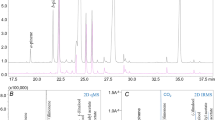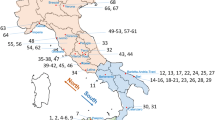Abstract
Virgin olive oil (VOO) is typified by characteristic, pleasant sensory notes that differentiate it from other edible oils. Sensory taste, together with nutritional aspects, is the main reason for the increase in consumption of VOO in recent years. Sensory analysis is required by European Official Regulations for olive oil in order to classify the product in commercial categories. In this study, the relationship between sensory and chemical composition has been investigated. In particular, 16 VOO samples (15 from a single variety of olives), produced in Italy and Spain (eight from each country), were analyzed. Sensory attributes were valued by four panels (three officially recognized both by IOOC and National Ministry: two Italian and two Spanish) employing a total of 59 tasters. Volatile and phenolic compounds were related to olfactory and gustative notes, respectively. Volatile compounds were then separated, identified, and quantified, starting from oil samples, by solid phase microextraction and capillary gas chromatographic analysis using a mass spectrometry detector (SPME/cGC-MSD). Furthermore, the phenolic profile was examined by high-performance liquid chromatography with diode-array and mass spectrometry detectors (HPLC-DAD/MSD). Correlations were found between the major volatile compounds (sum of aldehydes C6) and orthonasal perception of olive fruity and retronasal odor of almond. Additional correlations with bitterness and pungency were observed for tyrosol and oleuropein aglycon, respectively.




Similar content being viewed by others
Abbreviations
- cGC:
-
Capillary gas chromatography
- DAD:
-
Diode-array detector
- EI:
-
Electron ionization
- HPLC:
-
High-performance liquid chromatography
- IOOC:
-
International Olive Oil Council
- LOX:
-
Lipoxygenase
- MSD:
-
Mass-spectrometer detector
- QDA:
-
Quantitative descriptive analysis
- SPME:
-
Solid phase microextraction
- VOO:
-
Virgin olive oil
References
Andrewes P, Busch J-L-H-C, De Joode T, Groenewegen A, Alexandre H (2003) Sensory properties of virgin olive oil polyphenols: identification of deacetoxy-ligstroside aglycon as a key contributor to pungency. J Agric Food Chem. 51:1415–1420
Angerosa A (2002) Influence of volatile compounds on virgin olive oil quality evaluated by analytical approaches and sensor panels. Eur J Lipid Sci Technol 104:639–660
Angerosa F, Servili M, Selvaggini R, Taticchi A, Esposto S, Montedoro G-F (2004) Volatile compounds in virgin olive oil: occurrence and their relationship with the quality. J Chromatogr A 1054:17–31
Beauchamp G-K, Keast R-S-J, Morel D, Lin J-M, Pika J, Han Q, Lee C-H, Smith A-B, Breslin P-A-S (2005) Phytochemistry—ibuprofen-like activity in extra-virgin olive oil. Nature 437:45–46
Beltrán G, Ruano MT, Jiménez A, Uceda M, Aguilera MP (2007) Evaluation of virgin olive oil bitterness by total phenol content analysis. Eur J Lipid Sci Technol 109:193–197
Bendini A, Cerretani L, Carrasco-Pancorbo A, Gómez-Caravaca AM, Segura-Carretero A, Fernández-Gutiérrez A, Lercker G (2007a) Phenolic molecules in virgin olive oils: a survey of their sensory properties, health effects, antioxidant activity and analytical methods. An overview of the last decade. Molecules 12:1679–1719
Bendini A, Cerretani L, Lercker G (2007b) Survey on quality of virgin olive oils produced in Romagna. Riv Ital Sostanze Grasse 84:191–202
Bortolomeazzi R, Berno P, Pizzale L, Conte L-S (2001) Sesquiterpene, alkene, and alkane hydrocarbons in virgin olive oils of different varieties and geographical origins. J Agric Food Chemi 49:3278–3283
Burdock GA (2005) Fenaroli’s handbook of flavor ingredients, 5th edn. CRC Press, N.W. Corporate Blvd., Boca Raton
Carrasco-Pancorbo A, Cerretani L, Bendini A, Segura-Carretero A, Gallina Toschi T, Fernández-Gutiérrez A (2005a) Analytical determination of polyphenols in olive oils. J Sep Sci 28:837–858
Carrasco-Pancorbo A, Cerretani L, Bendini A, Segura-Carretero A, Del Carlo M, Gallina-Toschi T, Lercker G, Compagnone D, Fernández-Gutiérrez A (2005b) Evaluation of the antioxidant capacity of individual phenolic compounds in virgin olive oil. J Agric Food Chem 53:8918–8925
Cerretani L, Bendini A, Rotondi A, Lercker G, Toschi T-G (2005) Analytical comparison of monovarietal virgin olive oils obtained by both a continuous industrial plant and a low-scale mill. Eur J Lipid Sci Technol 107:93–100
Cerretani L, Bendini A, Del Caro A, Piga A, Vacca V, Caboni M-F, Gallina Toschi T (2006) Preliminary characterisation of virgin olive oils obtained from different cultivars in Sardinia. Eur Food Res Technol 222:354–361
Cerretani L, Biasini G, Bonoli-Carbognin M, Bendini A (2007) Harmony of virgin olive oil and food pairing: a methodological proposal. J Sens Stud 22:403–416
Cochran WG, Cox GM (1957) Design of experiments, 2nd edn. Wiley, New York
Di Lecce G, Bendini A, Cerretani L, Bonoli-Carbognin M, Lercker G (2006) Evaluation of “home consumption conditions” on shelf-life of extra virgin olive oils. Ind Aliment-Italy 45:873–81
European Community, Commission Regulation (1991) No 2568/91/EEC, July 11 Official Journal of the European Communities, L248, 1–83
European Community, Commission Regulation (2002) 796/2002 of 6 May 2002 amending Regulation No 2568/91/EEC, Official Journal of the European Communities, L128, 8–28
European Community, Commission Regulation (2003) 1989/2003 of 6 November 2003 amending Regulation No 2568/91/EEC, Official Journal of the European Communities, L295, 57–77
European Community, Commission Regulation (2008) 640/2008 of 4 July 2008 amending Regulation No 2568/91/EEC, Official Journal of the European Communities, L178, 11–16
Guth H, Grosch W (1993) Quantitation of potent odorants of virgin olive oil by stable isotope dilution assay. J Am Oil Chem Soc 70:513–518
Gutiérrez-Rosales F, Albi M-A, Palma R, Rios J-J, Olías J-M (1989) Bitter taste of virgin olive oil: correlation of sensory evaluation and instrumental HPLC analysis. J Food Sci 54:68–70
Gutiérrez-Rosales F, Perdiguero S, Gutiérrez R, Olias J-M (1992) Evaluation of the bitter taste in virgin olive oil. J Am Oil Chem Soc 69:394–395
Gutiérrez-Rosales F, Ríos J-J, Gómez-Rey M-L (2003) Main polyphenols in the bitter taste of virgin olive oil. Structural confirmation by on-line high-performance liquid chromatography electrospray ionization mass spectrometry. J Agric Food Chem 51:6021–6025
International Olive Oil Council (1987) Sensory analysis of olive oil—method—organoleptic assessment of virgin olive oil. COI/T.20/Doc. no. 3. Madrid, June 18th
International Olive Oil Council (2007) Economic: Survey & Assessment Division. www.internationaloliveoil.org
Kalua C-M, Allen M-S, Bedgood D-R, Bishop A-G, Prenzler P-D, Robards K (2007) Olive oil volatile compounds, flavour development and quality: a critical review. Food Chem 100:273–286
Menendez JA, Vazquez-Martin A, Colomer R, Brunet J, Carrasco-Pancorbo A, Garcia-Villalba R, Fernandez-Gutierrez A, Segura-Carretero A (2007) Olive oil’s bitter principle reverses acquired autoresistance to trastuzumab (Herceptin™) in HER2-overexpressing breast cancer cells. BMC Cancer 7, art. no. 80
Morales M-T, Tsimidou M (2000) The role of volatile compounds and polyphenols in olive oil sensory quality. In: Harwood J, Aparicio R (eds) Handbook of olive oil: analysis and properties. Aspen Publishers, Gaithersburg, pp 393–458
Morales M-T, Aparicio R, Rios JJ (1994) Dynamic headspace gas chromatographic method for determining volatiles in virgin olive oil. J Chromatogr A 668:455–462
Morales M-T, Luna G, Aparicio R (2005) Comparative study of virgin olive oil sensory defects. Food Chem 91:293–301
Pirisi F-M, Cabras P, Falqui Cao C, Migliorini M, Mugelli M (2000) Phenolic compounds in virgin olive oil. 2. Reappraisal of the extraction, HPLC separation, and quantification procedures. J Agric Food Chem 48:1191–1196
Procida G, Giomo A, Cichelli A, Conte L-S (2005) Study of volatile compounds of defective virgin olive oils and sensory evaluation: a chemometric approach. J Sci Food Agric 85:2175–2183
Rotondi A, Bendini A, Cerretani L, Mari M, Lercker G, Toschi T-G (2004) Effect of olive ripening degree on the oxidative stability and organoleptic properties of cv. Nostrana di Brisighella extra virgin olive oil. J Agric Food Chem 52:3649–3654
Siliani S, Mattei A, Benevieri Innocenti L, Zanoni B (2006) Bitter taste and phenolic compounds in extra virgin olive oil: an empirical relationship. J Food Qual 29:431–441
Vichi S, Pizzale L, Conte L-S, Buxaderas S, Lopez-Tamames E (2003) Solid-phase microextraction in the analysis of virgin olive oil volatile fraction: characterization of virgin olive oils from two distinct geographical areas of northern Italy. J Agric Food Chem 51:6572–6577
Zunin P, Boggia R, Salvadeo P, Evangelisti F (2005) Geographical traceability of west Liguria extravirgin olive oils by the analysis of volatile terpenoid hydrocarbons. J Chromatogr A 1089:243–249
Acknowledgments
The authors would like to acknowledge the enormous help and willingness of the four taste panel leaders Barbara Alfei (Ancona), Stefano Terenziani (Perugia), Juan Ramón Izquierdo (Madrid), Sergio Gómez-Alonso (Toledo), and especially all the assessors that contributed to this experimental research.
Author information
Authors and Affiliations
Corresponding authors
Rights and permissions
About this article
Cite this article
Cerretani, L., Salvador, M.D., Bendini, A. et al. Relationship Between Sensory Evaluation Performed by Italian and Spanish Official Panels and Volatile and Phenolic Profiles of Virgin Olive Oils. Chem. Percept. 1, 258–267 (2008). https://doi.org/10.1007/s12078-008-9031-3
Received:
Accepted:
Published:
Issue Date:
DOI: https://doi.org/10.1007/s12078-008-9031-3




